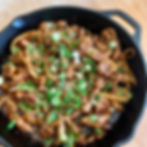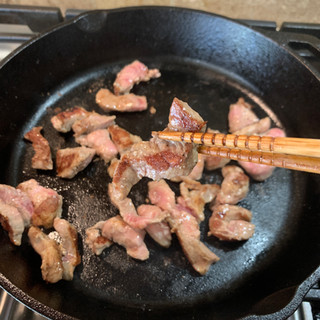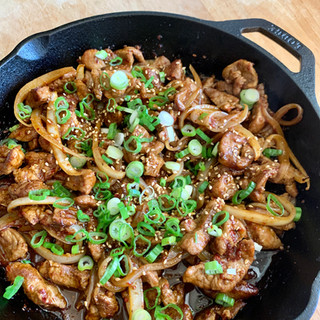Low sodium spicy pork (beef, or chicken) bulgogi
- Thuy
- Jul 21, 2021
- 4 min read
Updated: Jul 22, 2021
Cooking low sodium obviously means I use low sodium ingredients, but it also means I change the way I would normally cook a dish. Bulgogi is often marinated and then cooked or grilled over high heat. But without salt, the sweet marinade does very little to add flavor and makes it hard to get a good sear on the meat without burning. So instead, I don't marinate at all. I sear small batches of meat to build flavor and then add the sauce at the end. The sauce cooks quickly so that the meat is still tender and flavorful without getting tough and chewy.
Servings: 4
Sodium: 80 mg sodium per serving Time: 45 minutes

Ingredients:
1 pound pork shoulder or butt, cut into thin 1/4 inch strips
1/2 large sweet onion, sliced thin
2 tablespoons low sodium soy sauce substitute
2 tablespoons sesame oil
2 tablespoons dark brown sugar
1 tablespoon sherry vinegar
6 cloves garlic, pressed or minced
1 teaspoon ginger, minced
1 tablespoon hot sauce (optional)
1 tablespoon gochugaru (Korean hot pepper flakes)
1 tablespoon balsamic vinegar
2 scallions, chopped small and sesame seeds for garnish
A note on ingredients:
-This recipe works well with beef or chicken, too. Omit all the spicy ingredients if you don't want it spicy. Whatever meat you use, go with a cut that has a little fat in it. For pork, I like pork shoulder or butt. Pork belly is too fatty for me, and loin is too lean. For beef, ribeye or chuck are great. That said, I've made this with leaner cuts like chicken breast or top round and it still works, you'll just want to cook it a little differently. See my tips in steps 3 and 4.
-I use my own homemade low sodium soy sauce that has just 5 mg of sodium per tablespoon. Use up to 2 tablespoons of whatever substitute you can for soy sauce, like coconut aminos, low sodium tamari or soy sauce, Worcestershire sauce. Any savory sauce will work. Same with the hot sauce, use whatever works for your diet.
-Brown sugar gives it the best flavor but if you don't have dark brown sugar, use light brown or use white sugar with a teaspoon of molasses. Or just use white sugar on its own.
-Try to get gochugaru if you can, it has a differently flavor than the red chili flakes you would put on pizza.
1) Prepare the sauce: in a small bowl, combine 2 tablespoons low sodium soy sauce substitute, 2 tablespoons sesame oil, 2 tablespoons dark brown sugar, 1 tablespoon sherry vinegar, 6 cloves garlic, pressed or minced, 1 teaspoon ginger, minced, 1 tablespoon hot sauce (optional), and 1 tablespoon gochugaru (Korean hot pepper flakes) and stir to dissolve the sugar. Do NOT add the balsamic vinegar to the sauce, it goes in later on its own. Set aside.

2) Sauté the onions and set aside. In a cast iron or other heavy bottom skillet, heat a thin layer of oil and sauté the onions until just soft. I always cut my onions from tip to tip rather than in cross sections for cooking. It's partly out of habit because that's how I learned, but I also think they taste better and cook better this way.
3) Cook the meat. Add a thin layer of cooking oil to a cast iron or heavy bottomed skillet and cook small batches of meat. Lay the meat out in a single layer and don't disturb it, give it a chance to develop a nice sear for about 2 minutes. I use a 10-inch cast iron skillet and for 1 pound of pork, I cook it in 3 separate batches. The pork should be just a little pink when done. After each batch is done, transfer to the bowl with the onions.
For a leaner cut of meat, cut the pieces thinner.
4) Add the sauce to the meat and onions. Return the cook pork and onions to the hot skillet, and with the heat still on high, add the sauce and stir to coat. Cook for about a minute or two until the sauce thickens just slightly then turn off the heat.
If you are using a very lean cut of meat, add just the sauce to your hot skillet and let it get very hot and bubbly, then add the meat and onions to the sauce and turn off the heat immediately. Lean meats will cook and dry out faster, so you want to minimize the time the meat is cooking in the sauce here. Even a minute or two in a hot sauce will make it tough and chewy and negate all that effort you put into giving it a nice sear.
5) Add balsamic vinegar. Once the sauce is no longer bubbling, add 1 tablespoon of balsamic vinegar, stir, and garnish with toasted sesame seeds and scallions. I find this splash of balsamic vinegar after cooking gives the pork a unique flavor that you don't get by cooking the vinegar in the sauce.

Serve hot with rice or wrap it in lettuce or perilla leaves with some low sodium gochujang sauce (that *kind of* tastes like ssamjang). The picture below-left is beef, below-right is spicy pork. I generally do the pork and chicken spicy, but not the beef.



















